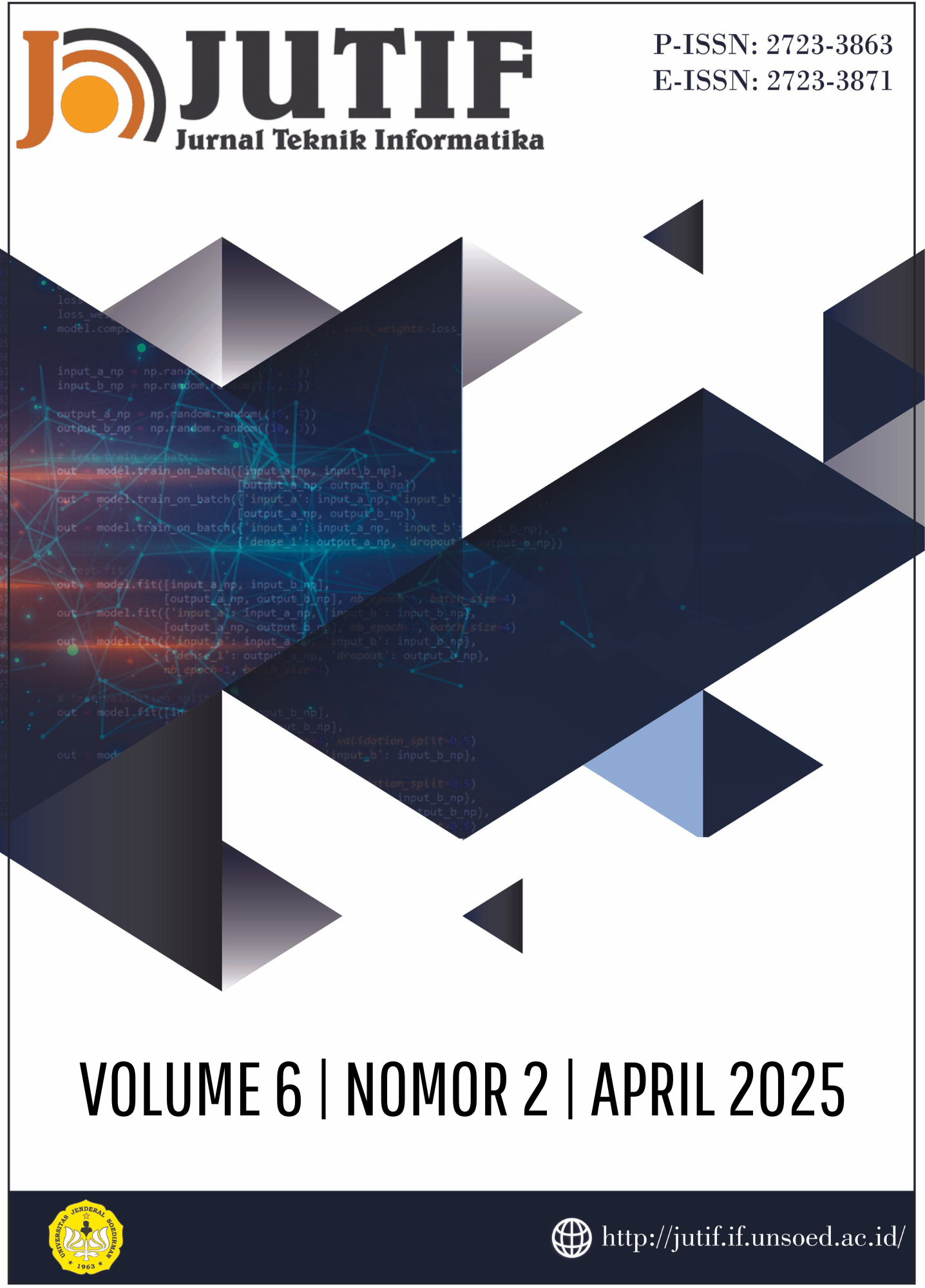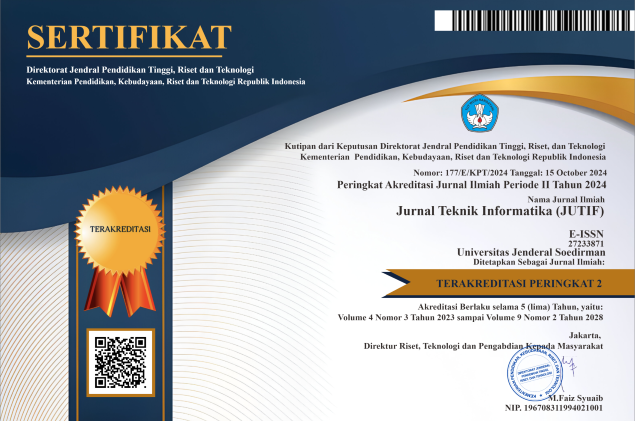Imperceptible Watermarking Using Discrete Wavelet Transform and Daisy Descriptor for Hiding Noisy Watermark
DOI:
https://doi.org/10.52436/1.jutif.2025.6.2.4423Keywords:
Daisy Descriptor, Discrete Wavelet Transform, Gaussian Noise, Image Watermarking, Salt&Peppers NoiseAbstract
This research aims at overcoming the challenge of improving security and robustness in digital image watermarking, a critical activity in protecting intellectual property against misuse and manipulation. In a move to overcome such a challenge, this work introduces a new form of watermarking that incorporates Discrete Wavelet Transform (DWT) and Daisy Descriptor, with a view to enhancing both durability and invisibility of the watermark. The proposed method embeds a noise-variant watermark into selected frequency sub-bands using DWT, while the Daisy Descriptor enhances resistance to noise-based attacks. Testing conducted with three grayscale images, namely Lena, Cameraman, and Lion, each with a resolution of 512 × 512 pixels, showed that the proposed DWT-Daisy Descriptor outperforms current methodologies, producing high Peak Signal-to-Noise Ratio (PSNR) and Structural Similarity Index (SSIM) values. In fact, in Lena, a PSNR value of 63.71 dB and an SSIM value of 1 were attained, with Cameraman having a PSNR value of 68.33 dB and an SSIM value of 1. As for attack resistivity, a high PSNR value of 50.11 dB under Gaussian attack and 55.70 dB under Salt-and-Pepper attack, with SSIM values approaching 1, confirm the robustness of the proposed scheme. This study highlights the significance of an efficient and secure watermarking technique that not only preserves image quality but also withstands various distortions, making it highly relevant for digital content protection in modern multimedia applications.
Downloads
References
[2] W. Alomoush et al., “Digital image watermarking using discrete cosine transformation based linear modulation,” Journal of Cloud Computing, vol. 12, no. 1, Dec. 2023, doi: 10.1186/s13677-023-00468-w.
[3] N. R. D. Cahyo and M. M. I. Al-Ghiffary, “An Image Processing Study: Image Enhancement, Image Segmentation, and Image Classification using Milkfish Freshness Images,” IJECAR) International Journal of Engineering Computing Advanced Research, vol. 1, no. 1, pp. 11–22, 2024.
[4] P. Aberna and L. Agilandeeswari, “Digital image and video watermarking: methodologies, attacks, applications, and future directions,” Multimed Tools Appl, vol. 83, no. 2, pp. 5531–5591, Jan. 2024, doi: 10.1007/s11042-023-15806-y.
[5] A. K. Sahu et al., “A Study on Content Tampering in Multimedia Watermarking,” SN Comput. Sci., vol. 4, no. 3, Feb. 2023, doi: 10.1007/s42979-022-01657-1.
[6] S. M. Darwish and L. D. S. Al-Khafaji, “Dual Watermarking for Color Images: A New Image Copyright Protection Model based on the Fusion of Successive and Segmented Watermarking,” Multimed Tools Appl, vol. 79, no. 9–10, pp. 6503–6530, Mar. 2020, doi: 10.1007/s11042-019-08290-w.
[7] S. Gupta, K. Saluja, V. Solanki, K. Kaur, P. Singla, and M. Shahid, “Efficient methods for digital image watermarking and information embedding,” Measurement: Sensors, vol. 24, p. 100520, Dec. 2022, doi: 10.1016/j.measen.2022.100520.
[8] E. Kartikadarma, E. D. Udayanti, C. A. Sari, and M. Doheir, “A Comparison of Non Blind Image Watermarking Using Transformation Domain,” Scientific Journal of Informatics, vol. 8, no. 1, 2021, doi: 10.15294/sji.v8i1.28334.
[9] J. Khandelwal, V. K. Sharma, D. Singh, and A. Zaguia, “Dwt-svd based image steganography using threshold value encryption method,” Computers, Materials and Continua, vol. 72, no. 2, pp. 3299–3312, 2022, doi: 10.32604/cmc.2022.023116.
[10] A. Alzahrani, “Enhanced invisibility and robustness of digital image watermarking based on DWT-SVD,” Appl Bionics Biomech, vol. 2022, 2022.
[11] F. Yasmeen and M. S. Uddin, “An Efficient Watermarking Approach Based on LL and HH Edges of DWT–SVD,” SN Comput Sci, vol. 2, no. 2, pp. 1–16, Apr. 2021, doi: 10.1007/s42979-021-00478-y.
[12] C. A. Sari et al., “A Chaotic Image Encryption Based on Random Noise and Arnold Cat Maps,” in 2024 International Seminar on Application for Technology of Information and Communication (iSemantic), IEEE, Sep. 2024, pp. 347–352. doi: 10.1109/iSemantic63362.2024.10762216.
[13] Y. Yuan, J. Li, U. A. Bhatti, M. Yang, and Q. Zhang, “Robust Color Images Zero-Watermarking Algorithm Based on Stationary Wavelet Transform and Daisy Descriptor,” in Deep Learning for Multimedia Processing Applications, CRC Press, 2024, pp. 60–73.
[14] N. S. Awarayi, O. Appiah, B. A. Weyori, and C. B. Ninfaakang, “A Digital Image Watermarking Using Dwt and L-shaped Tromino Fractal Encryption,” International Journal of Image, Graphics and Signal Processing, vol. 13, no. 3, pp. 33–43, Jun. 2021, doi: 10.5815/ijigsp.2021.03.03.
[15] A. Kumar, “A Review on Implementation of Digital Image Watermarking Techniques Using LSB and DWT,” in ss, 2020, pp. 595–602. doi: 10.1007/978-981-13-7166-0_59.
[16] T. Badings et al., “Robust Control for Dynamical Systems with Non-Gaussian Noise via Formal Abstractions,” Journal of Artificial Intelligence Research, vol. 76, pp. 341–391, Jan. 2023, doi: 10.1613/jair.1.14253.
[17] H. Zaini and Z. Alqadi, “High Salt and Pepper Noise Ratio Reduction,” International Journal of Computer Science and Mobile Computing, vol. 10, no. 9, pp. 88–97, Sep. 2021, doi: 10.47760/ijcsmc.2021.v10i09.009.
[18] J. Ebrahimnejad and A. Naghsh, “Adaptive Removal of high-density salt-and-pepper noise (ARSPN) for robust ROI detection used in watermarking of MRI images of the brain,” Comput Biol Med, vol. 137, p. 104831, Oct. 2021, doi: 10.1016/j.compbiomed.2021.104831.
[19] Y. Yuan, J. Li, U. A. Bhatti, M. Yang, and Q. Zhang, “Robust Color Images Zero-Watermarking Algorithm Based on Stationary Wavelet Transform and Daisy Descriptor,” in Deep Learning for Multimedia Processing Applications, CRC Press, 2024, pp. 60–73.
[20] S. S. Rao, G. K. Narula, R. Sudhir, S. S, R. B, and B. B, “Video Codec IP using Discrete Wavelet Transform,” in 2021 International Conference on Smart Generation Computing, Communication and Networking (SMART GENCON), IEEE, Oct. 2021, pp. 1–7. doi: 10.1109/SMARTGENCON51891.2021.9645895.
[21] P. N. Andono and C. A. Sari, “Remove Blur Image Using Bi-Directional Akamatsu Transform and Discrete Wavelet Transform,” Scientific Journal of Informatics, vol. 9, no. 2, pp. 179–188, Nov. 2022, doi: 10.15294/sji.v9i2.34173.
[22] W. W. Hu, R. G. Zhou, J. Luo, S. X. Jiang, and G. F. Luo, “Quantum image encryption algorithm based on Arnold scrambling and wavelet transforms,” Quantum Inf Process, vol. 19, no. 3, Mar. 2020, doi: 10.1007/s11128-020-2579-9.
[23] S. Pramanik, “An adaptive image steganography approach depending on integer wavelet transform and genetic algorithm,” Multimed Tools Appl, vol. 82, no. 22, pp. 34287–34319, Sep. 2023, doi: 10.1007/s11042-023-14505-y.
[24] C. A. Sari, M. H. Dzaki, E. H. Rachmawanto, R. R. Ali, and M. Doheir, “High PSNR Using Fibonacci Sequences in Classical Cryptography and Steganography Using LSB,” International Journal of Intelligent Engineering and Systems, vol. 16, no. 4, pp. 568–580, 2023, doi: 10.22266/ijies2023.0831.46.
[25] E. R. Pramudya et al., “Optimation of image encryption using fractal Tromino and polynomial Chebyshev based on chaotic matrix,” TELKOMNIKA (Telecommunication Computing Electronics and Control), vol. 22, no. 6, p. 1529, Aug. 2024, doi: 10.12928/telkomnika.v22i6.26080.
[26] U. Sara, M. Akter, and M. S. Uddin, “Image Quality Assessment through FSIM, SSIM, MSE and PSNR—A Comparative Study,” Journal of Computer and Communications, vol. 07, no. 03, pp. 8–18, 2019, doi: 10.4236/jcc.2019.73002.
Additional Files
Published
How to Cite
Issue
Section
License
Copyright (c) 2025 Abdussalam, Chaerul Umam, Wellia Shinta Sari, Eko Hari Rachmawanto, Guruh Fajar Shidik, Pulung Nurtantio Andono, Heru Lestiawan, Hussain Md Mehedul Islam

This work is licensed under a Creative Commons Attribution 4.0 International License.



























